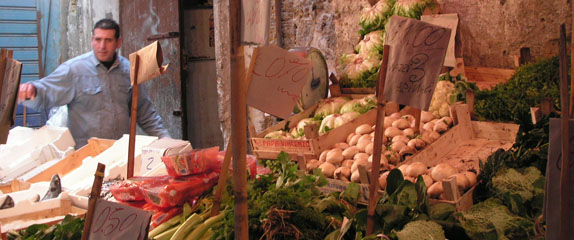SPRINGTIME IN SICILYIn the markets of Palermo, vendors share deliciously imprecise recipes
PALERMO, Italy — Nestled among the faded gray and peeling concrete buildings, some still cratered by World War II bombings, sits one of the liveliest markets in Sicily. Bright red and blue awnings cover hundreds of stalls in the colorful Ballarò, the most extensive of many markets in this charming, chaotic city.
I traverse the warren of vendors and happen upon a butcher selling all the cuts of beef you don’t recognize, as well as the innards. A fishmonger cuts thin steaks from local Mediterranean swordfish for a popular dish made with seasoned breadcrumbs. Giuseppe Bronte grabs the stem of a gigantic green-yellow broccolo, a variety of cauliflower, with his rough hands and hacks off the thick stem. Bronte belts out a rhythmic call, letting everyone know what he’s selling, his voice joining the cacophony of shouts and sounds.
My husband and I are spending two months in the seaside town of Mondello, just 20 harrowing minutes (what drivers!) from Palermo. Our studio apartment in a wisteria-covered stucco house, set on a steep hillside facing the Mediterranean Sea, has something that approximates a kitchen, with a briefcase-size four-burner stovetop. Two narrow shelves hold sea salt, olive oil, and dried wild oregano, all local staples. A few pots and pans are in the cabinet. In other words, a basic but sufficient setup for exploring Sicilian cooking and the recipes shared with me while foraging through markets.
In Sicily, as in the rest of Italy, if you buy something from a vendor, you’re almost obligated to hear what a wife or mother or sister would do with that particular ingredient. Here, everyone has an opinion about cooking. And no one has an exact recipe for anything.
This is a friendly place, and vendors are luring you over to try his goods. A roly-poly baker is selling sesame-studded loaves and pita-like breads with spongy interiors from Monreale, a town famous for its cathedral and bakeries. A few steps away, I encounter a hill of black and green olives, then wheels of pepper-studded pecorino. ”How about a taste?” asks the big-bellied proprietor.
The kind and patient Providenza Di Noto has become a favorite. Her 70-year-old shop is on the periphery of another open-air market, the Vucciria. ”Più o meno” — ”more or less” — is how she describes measurements for minestrone soup. Her brother, Sandro, interjects. After a heated exchange about onions, she turns back and says triumphantly, ”One. Big one.” Then her usual ”more or less.” She puts her index finger to her cheek and twists it — the gesture that describes anything delicious in Sicily. ”Buonissimo,” she says, eyes cast upward.
Di Noto’s mixture of dried chickpeas, green and red lentils, white beans, cranberry beans, and split favas sits in a sack near the front of her shop. As she dips her scoop in, she continues her impromptu cooking lesson. I understand about every fifth word, but I do catch how to break the spaghetti into the soup because she mimes it as she goes. The low tables at her stall are covered with hand-labeled packets of mixed spices, sun-dried tomatoes, salted capers, and glass jars of anchovies. Little bags of a currant and pine nut mix, a sampling of the Arab influence on Sicilian cuisine, hang on one wall. Beans in hand, I navigate the narrow lanes to gather the remaining ingredients for my pot.
Later, while the soup is simmering, I get a call from friends of friends. Palermo resident Ludovico Ziino, a retired pediatrician who loves to cook, asks if we can join him and his wife, Giulia, for dinner the next week (like most Sicilians, the invitation is for 9 p.m. — often my bedtime). Dinner, he tells me, will consist of ”specialties from Palermo — my grandmother’s recipes.”
At Ziino’s house in the heart of the city, at a table laid with heirloom linens and silver, we dine on large shell pasta tossed with the green-yellow cauliflower I’ve seen all over the markets and a saffron-scented, slightly sweet sauce made with pine nuts and currants. This dish is typically made with bucatini (pasta straws), but Ziino used shells to better cradle his aromatic sauce. Everyone is chattering about how the dish is made. When I ask how much saffron, Ziino looks at his large hand, puts his thumb to the top joint of his pinky, and in his deep bass tells me, ”About this much — more or less.” I add the cauliflower and pasta dish to my list of meals to try.
Visiting the fish stalls on the pier in Mondello early one morning, I listen as shoppers bargain with the fishmongers. The miniscule, opalescent neonata (newborn fish) glisten in a pile. I turn to the gentleman who has just bought a bagful and ask how to prepare them. Make a little fried fish cake, he tells me emphatically, with olive oil, salt, pepper, an egg, and just enough flour — more or less! — to hold it all together. Fry in a spoonful of oil, he continues, and when it turns white, sprinkle with lemon juice and eat right away. This, he says, is ”the end of the world.” Then he sighs, dreamily, slightly shaking his hands, which are cupped, prayer-like.
Across the street at the Schillaci family’s shop, wooden crates of oranges, pears, artichokes, those handsome giant green-yellow cauliflowers, and eggplant spill out onto the piazza. I buy two pounds of cipolline — tiny, squat onions — to prepare in a sweet and sour sauce. This is a recipe that the entire Schillaci family — and several customers — gave me the week before.
Offering their advice in loud voices, everyone speaking at once, they instructed me to balance the wine vinegar and the sugar. The amount of each, of course, is several spoonfuls.
That is, more or less.











 Debra Samuels, bestselling author, food writer and cooking instructor,
Debra Samuels, bestselling author, food writer and cooking instructor, 


